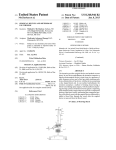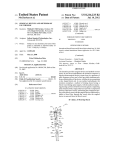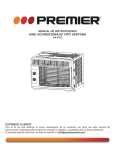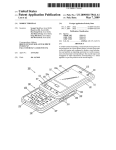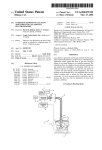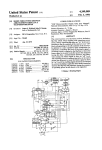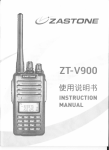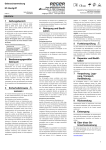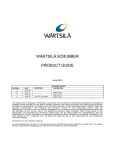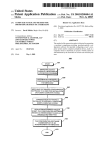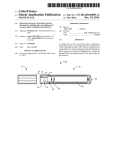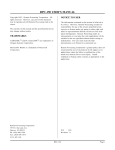Download Surgical Devices And Methods of Use Thereof
Transcript
US 20120253343Al (19) United States (12) Patent Application Publication (10) Pub. No.: US 2012/0253343 A1 McClurken et al. (54) (43) Pub. Date: SURGICAL DEVICES AND METHODS OF USE THEREOF (76) lnvemorsl El-lMccglrgen, Purham, ; oger . (51) Oct. 4, 2012 Publication Classi?cation Int CL A61B 18/14 (2006.01) (52) us. Cl. ........................................................ .. 606/41 ree ey, Portsmouth, NH (U S); Brian M. Conley, South BerWick, ME (U S) (57) ABSTRACT The invention provides surgical devices and methods to treat tissue. In one device embodiment, the invention comprises a (21) App1_ NO; (22) Flled' - 13/494,574 bipolar electrosurgical device to treat tissue in a presence of radio frequency poWer and a ?uid provided simultaneously Jun' 12’ 2012 a disc shaped distal end. In one method embodiment, the _ from a distal portion of the device, With the device comprising _ _ invention comprises a method of treating tissue having a Related U's' Apphcatlon Data (62) Division of application NO‘ 12/053 030 ?led on Mar‘ 21 2008 HOW Pat NO 8 216 233 ’ ’ (60) blood vessel during spine surgery, With the method compris ’ ' ' ’ ’ ’ ' Provisional application No. 60/896,768, ?led on Mar. 23, 2007. SOOc mg pressing a port1on ofthe blood vessel agamst a supporting spine structure With a surgical device to provide a compressed portion of the blood vessel, and heating the compressed por tion of the blood vessel With the surgical device suf?ciently to inhibit a blood ?oW through the vessel after the surgical device is removed from the blood vessel. Patent Application Publication FIG. 1’ Oct. 4, 2012 Sheet 1 0f 15 US 2012/0253343 A1 Patent Application Publication Oct. 4, 2012 Sheet 2 0f 15 US 2012/0253343 A1 : i w?.ri ,sbn i. sit‘ Patent Application Publication Oct. 4, 2012 Sheet 5 0f 15 US 2012/0253343 A1 mm . mm gj mm. :1v WWmm?@E Qm mmQ mm ww.5 QAWJ mmWW, w.$31 1 . ‘ 3mma;$E?“3 KNa‘ 5 gm ?mw“Em ?wgmwm $ M.3 “ i m “w_ 3 XL Patent Application Publication Oct. 4, 2012 Sheet 6 0f 15 US 2012/0253343 A1 B.nPHK Patent Application Publication Oct. 4, 2012 Sheet 7 0f 15 US 2012/0253343 A1 w.QUE. Patent Application Publication Oct. 4, 2012 Sheet 8 0f 15 US 2012/0253343 A1 Aw‘Riga Patent Application Publication Oct. 4, 2012 Sheet 9 0f 15 US 2012/0253343 A1 Patent Application Publication Oct. 4, 2012 Sheet 10 0f 15 Fl" e ‘i HQA US 2012/0253343 A1 Patent Application Publication Oct. 4, 2012 Sheet 11 0f 15 US 2012/0253343 A1 Patent Application Publication 30 Oct. 4, 2012 Sheet 12 0f 15 US 2012/0253343 A1 Patent Application Publication Oct. 4, 2012 Sheet 13 0f 15 my“; 3 a‘ Fm :5 US 2012/0253343 A1 IY Patent Application Publication Oct. 4, 2012 Sheet 14 0f 15 US 2012/0253343 Al Fiji; VF’ 2251 ii Kw My?‘ gag i E EZ Patent Application Publication Oct. 4, 2012 Sheet 15 0f 15 US 2012/0253343 A1 Z02. K221»: F2215 z3Q 2:5 a picmzxo gee Oct. 4, 2012 US 2012/0253343 A1 SURGICAL DEVICES AND METHODS OF USE THEREOF CROSS REFERENCE TO RELATED APPLICATIONS [0001] The present application claims the bene?t of the ?ling date of US. Provisional Application Ser. No. 60/896, 768, ?led Mar. 23, 2007, the teachings of Which are incorpo rated herein by reference. FIELD [0002] This invention relates to surgical devices, systems and methods for use upon tissues of a human body during surgery, particularly open surgery and minimally invasive surgery such as laparoscopic surgery. BACKGROUND [0003] A dry tip electrosurgical device, such as a Bovie pencil, can cause the temperature of tissue being treated to rise signi?cantly higher than 100° Celsius, resulting in tissue desiccation, tissue sticking to the electrodes, tissue perfora tion, char formation and smoke generation. [0004] Furthermore, certain surgical devices are too large to be used in con?ned surgical spaces and/or are simply ineffective in treating tissue, such as to inhibit blood loss. [0005] More recently, ?uid-assisted electrosurgical devices have been developed Which use saline to inhibit undesirable effects such as tissue desiccation, electrode sticking, smoke production and char formation during the treatment of tissue. terminates at a distal end comprising a disc shaped distal end. The disc shaped distal end comprises a ?rst semi-circular shaped electrode and a second semi-circular shaped elec trode. The device may further comprise a ?uid delivery pas sage being connectable to a ?uid source of ?uid and at least one ?uid exit in ?uid communication With the ?uid delivery passage. [0009] In another embodiment, the invention provides a method of treating tissue having a blood vessel during spine surgery With the method comprising pressing a portion of the blood vessel against a supporting spine structure With a sur gical device to provide a compressed portion of the blood vessel, and heating the compressed portion of the blood ves sel With the surgical device suf?ciently to occlude the blood vessel after the surgical device is removed from the blood vessel. In certain embodiments, the supporting spine struc ture comprises a vertebra, and more particularly, a vertebral body of the vertebra. [0010] In another embodiment, the invention provides a method of treating tissue having a blood vessel during surgery With the method comprising pressing a portion of the blood vessel against a bone structure With a surgical device to pro vide a compressed portion of the blood vessel, and heating the compressed portion of the blood vessel With the surgical device su?iciently to occlude the blood vessel after the sur gical device is removed from the blood vessel. [0011] In another embodiment, the invention provides an electrically poWered surgical device to be used during a sur gical procedure With the device comprising an aperture dispersion and cooling at the electrode-tissue interface. This reduces the temperature of the tissue being treated and, in formed in the device; the aperture having a button therein to activate the device, the aperture de?ned by a perimeter Wall surrounding the button; a narroW gap betWeen the button and the perimeter Wall, the narroW gap open to a ?oW of ?uid turn, can result in a longer treatment time to achieve the therein from the surgical procedure, the ?uid comprising desired tissue temperature for treatment of the tissue. Long blood; and the button having at least one side closely adjacent the perimeter Wall surrounding the button, the at least one side HoWever, too much saline can provide too much electrical treatment times are undesirable for surgeons since it is in the best interest of the patient, physician and hospital to perform surgical procedures as quickly as possible. of the button having at least one aperture formed therein to [0006] In light of the above, there is a need for devices and methods Which address the foregoing concerns. the blood. inhibit the button from adhering With the perimeter Wall by [0012] It is understood that the speci?c features described in these embodiments can be rearranged among the various SUMMARY OF THE INVENTION [0007] The invention, in one embodiment, provides an embodiments to provide devices, apparatus, systems and methods that fall Within the scope of this disclosure. electrosurgical apparatus to provide controlled delivery of radio-frequency poWer and a ?uid to an electrosurgical hand held device to treat tissue. The apparatus comprises a radio frequency generator to deliver the radio-frequency poWer, With the radio frequency poWer from the radio-frequency generator selectable at a radio-frequency poWer level; a pump to deliver the ?uid; a primer to prime the hand device With the ?uid; a control system to control a ?oW of the ?uid delivered by the pump With a functional relationship betWeen the radio frequency poWer level and the ?oW of the ?uid, the functional relationship to increase the ?oW of the ?uid in response to an increase in the radio-frequency poWer level and to decrease the ?oW of the ?uid in response to a decrease in the radio BRIEF DESCRIPTION OF THE DRAWINGS [0013] FIG. 1 is a front vieW of one embodiment of a system of the present invention having an electrosurgical unit in combination With a ?uid source and handheld electrosurgical device; [0014] FIG. 2 is a front perspective vieW of the electrosur gical unit of FIG. 1; [0015] FIG. 3 is a rear vieW of the electrosurgical unit of FIG. 1; [0016] FIG. 4 is a graph of the RF poWer output P0 versus changes the functional relationship betWeen the radio-fre impedance Z for the electrosurgical unit of FIG. 1; [0017] FIG. 5 is graph shoWing three relationships of ?uid ?oW rate Q of saline (at high QH, medium QMand loW QL) in quency poWer level and the ?oW of the ?uid. units of cubic centimetres per minute (cc/min) on the Y-axis, [0008] In another embodiment, the invention provides a bipolar electrosurgical device to treat tissue. The device com prises a handle and a shaft extending distally from the handle With the shaft supporting the distal portion of the device in rigid relation to the handle. The distal portion of the device and the RF poWer setting PS in units of Watts on the X-axis; [0018] FIG. 6 is a block diagram shoWing one embodiment frequency poWer level; and a ?uid ?oW selector Which of hoW the electrosurgical unit processes the inputs of RF poWer setting PS and the ?uid ?oW rate setting, either QL, QM or QH, to control the pump speed; Oct. 4, 2012 US 2012/0253343 A1 [0019] FIG. 7 is an isometric vieW of an assembly of an exemplary electrosurgical device according to the present invention; [0020] FIG. 8 is an isometric vieW of the inner components of the handle With the handle removed; [0021] FIG. 9 is a side vieW ofa handle portion ofthe device of FIG. 7 assembled With various components; [0022] FIG. 10 is a close-up side vieW of a button and handle portion of the device of FIG. 7 assembled With various components; [0023] FIG. 11 is an exploded vieW ofa distal portion ofthe device of FIG. 7; [0024] FIG. 12 is a close-up longitudinal cross-sectional vieW of a distal portion of the device of FIG. 7; [0025] FIG. 13 is a close-up longitudinal cross-sectional vieW of a distal portion of an alternative exemplary electro surgical device according to the present invention; [0026] FIG. 14 is a close-up longitudinal cross-sectional vieW of a distal portion of an alternative exemplary electro surgical device according to the present invention; store the electrosurgical unit’s user manual, as Well as addi tional unused devices. Furthermore, the support member 8 carries a platform 12 comprising a pedestal table to provide a ?at, stable surface for location of the electrosurgical unit 14. [0036] As shoWn, cart 2 further comprises a ?uid source carrying pole 16 having a height Which may be adjusted by sliding the carrying pole 16 up and doWn Within the support member 8 and thereafter secured in position With a set screW. On the top of the ?uid source carrying pole 16 is a cross support 18 provided With loops 20 at the ends thereof to provide a hook for carrying ?uid source 22. [0037] Returning to FIG. 1, ?uid source 22 comprises a bag of ?uid from Which the ?uid 24 ?oWs through a drip chamber 26 after the bag is penetrated With a spike located at the end of the drip chamber 26. Thereafter, ?uid 24 ?oWs through ?ex ible delivery tubing 28 to handheld electrosurgical device 30. Preferably the ?uid delivery tubing 28 is made from a poly mer material. [0038] As shoWn in FIG. 1, the ?uid delivery tubing 28 passes through pump 32. As shoWn pump 32 comprises a alternative exemplary electro surgical device according to the peristaltic pump and, more speci?cally, a rotary peristaltic pump. With a rotary peristaltic pump, a portion of the delivery tubing 28 is loaded into the pump head by raising and loWer present invention; ing the pump head in a knoWn manner. As best shoWn in FIG. [0027] FIG. 15 is an isometric vieW of a distal portion of an [0028] FIG. 16 is a close-up longitudinal cross-sectional vieW of the distal portion of the device of FIG. 15 taken along line 16-16; and [0029] FIG. 17 is a close-up vieW ofa distal portion of the device of FIG. 7 and tissue; [0030] FIG. 18 is a close-up vieW ofa distal portion of the device of FIG. 7 pressing against tissue; [0031] FIG. 19 is a close-up vieW ofa distal portion of the device of FIG. 7 being used to treat tissue; and [0032] FIG. 20 is a close-up vieW ofa distal portion of the device of FIG. 7 removed from treated tissue. DETAILED DESCRIPTION 6, ?uid 24 is conveyed Within the delivery tubing 28 by Waves of contraction placed externally on the tubing 28 Which are produced mechanically, typically by rotating pinch rollers 57 Which rotate on a drive shaft 55 and intermittently compress the tubing 28 against an anvil support 58. Alternatively, pump 32 may comprise a linear peristaltic pump. With a linear peristaltic pump, ?uid 24 is conveyed Within the delivery tubing 28 by Waves of contraction placed externally on the tubing 28 Which are produced mechanically, typically by a series of compression ?ngers or pads Which sequentially squeeze the tubing 28 against a support. Peristaltic pumps are generally preferred, as the electro-mechanical force mecha nism, here rollers driven by electric motor, does not make contact the ?uid 24, thus reducing the likelihood of inadvert ent contamination. [0033] Throughout the description, like reference numerals and letters indicate corresponding structure throughout the several vieWs. Also, any particular feature(s) of a particular exemplary embodiment may be equally applied to any other exemplary embodiment(s) of this speci?cation as suitable. In other Words, features betWeen the various exemplary embodi [0039] In a preferred embodiment the ?uid 24 comprises saline, and even more preferably, normal (physiologic) saline. Although the description herein may make reference to saline as the ?uid 24, other electrically conductive ?uids ments described herein are interchangeable as suitable, and not exclusive. From the speci?cation, it should be clear that become more apparent With further reading of this speci?ca tion, ?uid 24 may also comprise an electrically non-conduc any use of the terms “distal” and “proximal” are made in tive ?uid. The use of a non-conductive ?uid is less preferred than a conductive ?uid, hoWever, the use of a non-conductive reference from the user of the device, and not the patient. [0034] The inventions disclosed herein provide devices, systems and methods for treating tissue during a surgical procedure. These inventions are particularly useful for pro cedures Where it is desirable to shrink, coagulate and seal tissue against blood loss, for example, by shrinking lumens of blood vessels (e.g., veins, arteries). [0035] The invention Will noW be discussed With reference to the ?gures, With FIG. 1 shoWing a front vieW of one embodiment of a system of the present invention having an electrosurgical unit 14 in combination With a ?uid source 22 and a handheld electrosurgical device 30. FIG. 1 shoWs a movable cart 2 having a chassis 4 Which is provided With four Wheels 6 for easy transportation. The chassis 4 carries a can be used in accordance With the invention. [0040] While a conductive ?uid is preferred, as Will ?uid still provides certain advantages over complete elimina tion of the ?uid and the use of a dry electrode including, for example, reduced occurrence of tissue sticking to the elec trode of device 30 and cooling of the electrode and/ or tissue. Therefore, it is also Within the scope of the invention to include the use of a non-conducting ?uid, such as, for example, deioniZed Water. [0041] As shoWn in FIG. 1, electrosurgical device 30 is connected to electrosurgical unit 14 via a cable 34 Which comprises a plurality of electrically insulated Wire conductors and at least one plug 36 at the end thereof. The electrosurgical unit 14 provides radio-frequency (RF) energy/poWer via cable 34 to electrosurgical device 30. As shoWn in FIG. 2, vertical support member 8 comprising a holloW cylindrical plug receptacle 38 of electrosurgical unit 14 receives the plug post to Which a storage basket 10 may be fastened and used to 36 of device 30 therein to electrically connect device 30 to the Oct. 4, 2012 US 2012/0253343 A1 electrosurgical unit 14. Preferably the ?uid delivery tubing 28 [0048] is provided as part of cable 34 and produced With the electri 14. The rear panel of the electrosurgical unit 14 includes a speaker 60 and a volume control knob 62 to adjust the volume of the tone that Will sound When the RF poWer is activated (RF poWer activation tone). The volume of the RF poWer activa cally insulated Wires via plastic co-extrusion. [0042] FIG. 2 shows the front panel of the electrosurgical unit 14. A poWer sWitch 42 is used to turn the electrosurgical unit 14 on and off. After turning the electrosurgical unit 14 on, the RF poWer setting display 44 is used to display the RF poWer setting numerically in Watts. Preferably the poWer setting display comprises a liquid crystal display (LCD). Additionally, this display 44 is used to display errors, in Which case the display 44 Will shoW “Err” and blink alter nately With a special error code number(s). [0043] The RF poWer selector comprises RF poWer setting sWitches 46a, 46b Which are used to select the RF poWer setting. Pushing the sWitch 4611 increases the RE poWer set ting, While pushing the sWitch 46b decreases the RF poWer setting. RF poWer output may be set in 5 Watt increments in the range of 20 to 100 Watts, and 10 Watt increments in the range of 100 to 200 Watts. Additionally, electrosurgical unit 14 includes an RE poWer activation display 74 comprising an indicator light Which illuminates When RF poWer is activated. SWitches 46a, 46b may comprise membrane sWitches. [0044] In addition to having a RF poWer setting display, electrosurgical unit 14 further includes a ?uid ?oW rate set ting display. FloW rate setting display comprises three indi cator lights 50a, 50b and 500 With a ?rst light 50a correspond ing to a ?uid ?oW rate setting of loW, a second light 50b corresponding to a ?uid ?oW rate setting of medium (inter mediate) and a third light 500 corresponding to a ?oW rate setting of high. One of these three indicator lights Will illu minate When a ?uid ?oW rate setting is selected. [0045] A ?uid ?oW selector comprising ?oW rate setting sWitches 52a, 52b and 520 are used to select or sWitch the ?oW rate setting. Three push sWitches are provided With the ?rst sWitch 52a corresponding to a ?uid ?oW rate setting of loW, the second sWitch 52b corresponding to a ?uid ?oW rate setting of medium (intermediate) and the third switch 520 corresponding to a ?oW rate setting of high. Pushing one of these three sWitches selects the corresponding ?oW rate set ting of either loW, medium (intermediate) or high. The medium, or intermediate, ?oW rate setting is automatically selected as the default setting if no setting is manually selected. SWitches 52a, 52b and 520 may comprise mem brane sWitches. [0046] Before starting a surgical procedure, it is desirable to prime device 30 With ?uid 24. Priming is desirable to inhibit RF poWer activation Without the presence of ?uid 24. A priming sWitch 54 is used to initiate priming of device 30 With ?uid 24. Pushing sWitch 54 once initiates operation of pump 32 for a predetermined time period to prime device 30. After the time period is complete, the pump 32 shuts off automatically. When priming of device 30 is initiated, a prim ing display 56 comprising an indicator light illuminates dur FIG. 3 shoWs the rear panel of electrosurgical unit tion tone is increased by turning the knob clockWise, and decreased by turning the knob counterclockWise. HoWever, the electrosurgical unit 14 prevents this tone from being com pletely silenced. [0049] Rear panel of electrosurgical unit 14 also includes a poWer cord receptacle 64 used to connect the main poWer cord to the electrosurgical unit 14 and an equipotential grounding lug connector 66 used to connect the electrosurgical unit 14 to earth ground using a suitable cable. The rear panel also includes a removable cap 68 for the installation of a bipolar footsWitch socket connectable to an internal footsWitch cir cuit of electrosurgical unit 14 so that the RF poWer may be activated by a footsWitch in addition to a handsWitch of device 30. Additionally, the rear panel also includes a fuse draWer 70 Which includes Which contains tWo extra fuses, consistent With the line voltage. Finally, the rear panel includes a name plate 72 Which may provide information such as the model number, serial number, nominal line voltages, frequency, cur rent and fuse rating information of the electrosurgical unit 14. [0050] The RF poWer output curve of electrosurgical unit 14 is shoWn in FIG. 4. Impedance Z, shoWn in units of ohms on the X-axis and output poWer PO is shoWn in units of Watts on theY-axis. In the illustrated embodiment, the bipolar elec trosurgical poWer (RF) is set to 200 Watts. As shoWn in the ?gure, for an RF poWer setting PS of 200 Watts, the output poWer PO Will remain constant With the set RF poWer PS as long as the impedance Z stays betWeen the loW impedance cut-off of 30 ohms and the high impedance cut-off of 125 ohms. BeloW an impedance Z of 30 ohms, the output poWer P 0 Will decrease as shoWn by the loW impedance ramp. Above an impedance Z of 250 ohms, the output poWer PO Will also decrease as shoWn by the high impedance ramp. [0051] Electrosurgical unit 14 has also been con?gured such that the pump speed, and therefore the throughput of ?uid expelled by the pump, is predetermined based on tWo input variables, the RF poWer setting and the ?uid ?oW rate setting. In FIG. 5 there is shoWn a relationship of ?uid ?oW rate Q in units of cubic centimetres per minute (cc/min) on the Y-axis, and the RF poWer setting PS in units of Watts on the X-axis. The relationship has been engineered to inhibit unde sirable effects such as tissue desiccation, electrode sticking, smoke production and char formation, While at the same time providing a ?uid ?oW rate Q at a corresponding RF poWer setting PS Which is not so great as to provide too much ?uid and associated electrical dispersion and cooling at the elec trode-tissue interface. While not being bound to a particular theory, a more detailed discussion on hoW the ?uid ?oW rate interacts With the radio frequency poWer, modes of heat trans fer from the tissue, fractional boiling of the ?uid and various control strategies may be found in U.S. Publication No. 2001/ ing the priming cycle. 0032002, published Oct. 18, 2001, and assigned to the assignee of the present invention and hereby incorporated by [0047] reference in its entirety to the extent it is consistent. On the front panel the bipolar activation display 74 illuminates When RF poWer is activated from the electrosur gical unit 14, either via a hand sWitch 162 on device 30 (as shoWn in FIG. 1) or a footsWitch (not shoWn). A pullout draWer 76 is located under the electrosurgical unit 14 Where the user of electrosurgical unit 14 may ?nd a short form of the user’s manual. [0052] As shoWn, electrosurgical unit 14 has been con?g ured to increase the ?uid ?oW rate Q linearly With an increas ing RF poWer setting PS for each of three ?uid ?oW rate settings of loW, medium and high corresponding to QL, OM and OH, respectively. Conversely, electrosurgical unit 14 has been con?gured to decrease the ?uid ?oW rate Q linearly With Oct. 4, 2012 US 2012/0253343 A1 a decrease RF power setting PS for each of three ?uid ?oW rate [0058] settings of loW, medium and high corresponding to QL, QM and QH, respectively. As shown, QL, QM and QH can be nism, such as a [text missing or illegible when filed] automatically keep the ?uid ?oW on for several seconds after Electrosurgical unit 14 can include a delay mecha expressed as a function of the RF poWer setting PS by chang ing exemplary proportionality constants as folloWs: the RF poWer is deactivated to provide a post-treatment cool ing. Electrosurgical unit 14 can also include a delay mecha nism, such as a timer, to automatically turn on the ?uid ?oW up to several seconds before the RF poWer is activated to inhibit the possibility of undesirable effects as tissue desic cation, electrode sticking, char formation and smoke produc tion. [0059] Electrosurgical unit 14 is particularly con?gured for [0053] FIG. 6 shoWs an exemplary block diagram of hoW electrosurgical unit 14 processes the inputs of RF poWer setting PS and the ?uid ?oW rate setting, either QL, QM or QH, to control the pump speed, and therefore the throughput of ?uid expelled by the pump 32. As shoWn, user selected input values for the RF poWer setting PS and the ?uid ?oW rate setting of either loW, medium and high (corresponding to QL; QM and QH), as Well as activating the priming function, are entered into electrosurgical unit 14 by pushing corresponding sWitches for these parameters positioned on the front panel of the electrosurgical unit 14. [0054] As shoWn in FIG. 6, the RF poWer setting sWitches 46a, 46b, the ?oW rate setting sWitches 52a, 52b, 52c and the priming sWitch 54 are a display panel module 40, preferably comprising a printed circuit board, Which receives the inputs into electrosurgical unit 14. [0055] The user selected input values for RF poWer, ?uid ?oW rate and priming are then conveyed via corresponding input signals 41 to a main module 43 Which preferably com prises a printed circuit board including a computer chip 45, a radio-frequency generator 47 and a pump controller 48. As shoWn, display panel module 40 and main module 43, as Well as other components receive poWer from a poWer supply module 49, Which also comprises a printed circuit board. [0056] Computer chip 45 preferably comprises a micro processor unit, a memory, and an input/output control unit. In this manner, the functional relationships betWeen the radio frequency poWer level and the ?oW of the ?uid may be stored in the memory of the computer chip 45. While the functional relationships may be stored in the form of the foregoing equations, they may also be stored as numerical data points as part of a database look-up table. [0057] As shoWn, the input signals 41 are received and processed by computer chip 45. More speci?cally, for example, from the input signal received corresponding to the ?uid ?oW rate setting of either QL, QM or QH, the computer chip 45 may ?rst determine Which of the above equations to apply. After determining Which equation to apply, computer chip 45 may then apply the relationship to determine the output for ?oW of the ?uid from the pump 32 based on the selected radio-frequency poWer level. Having determined thi s use With bipolar devices. With a bipolar device, an alternating current is created betWeen the ?rst and second electrical poles of the device. An exemplary bipolar electrosurgical device of the present invention Which may be used in conjunction With electrosurgical unit 14 of the present invention is shoWn at reference character 30a in FIG. 7. While various electrosur gical devices of the present invention are described herein With reference to use With electrosurgical unit 14, it should be understood that the description of the combination is for purposes of illustrating the system of the invention. Conse quently, it should be understood that While the electrosurgical devices disclosed herein may be preferred for use With elec trosurgical unit 14, it may be plausible to use other electro surgical devices With electrosurgical unit 14 such as monopo lar devices, or it may be plausible to use the electrosurgical devices disclosed herein With another electrosurgical unit other than electrosurgical unit 14. [0060] As shoWn in FIG. 7, exemplary bipolar electrosur gical device 3011 comprises a single stationary arm 100 Which comprises a rigid, self-supporting, holloW shaft 102. As shoWn, shaft 102 is preferably angled to provide better vieW ing of the distal tip portion 106 of device 3011 during use thereof. Shaft 102 preferably comprises metal tubing, and more preferably thick Walled hypodermic stainless steel tub ing. In this manner, shaft 102 has su?icient rigidity to main tain its form during use of device 30a Without kinking or signi?cant bending, and support the distal portion 106 in rigid relation to a proximal handle 104. In other embodiments, shaft 102 may be made of an electrical non-conducting mate rial, such as a polymer or composite material. [0061] Proximal handle 104 comprises mating handle por tions 104a, 1041). Handle 104 is preferably made of a steril iZable, rigid, non-conductive material, such as a polymer. Also, handle 104 is preferably con?gured slender, along With the rest of the device 3011, to facilitate a user of device 3011 to hold and manipulate device 3011 like a pen-type device. [0062] Device 30a also comprises a ?exible ?uid delivery tubing 28 Which is connectable to ?uid source 22, preferably via a spike located at the end of drip chamber 26 (as shoWn in FIG. 1), and a cable 34 Which is connectable to electrosurgical unit 14, Which respectively provide ?uid and RF poWer to output, the computer chip 45 then sends output signals 51 and 53 corresponding to the selected radio-frequency poWer level distal portion 106. and calculated output for ?oW of the ?uid from the pump 32 to the radio-frequency generator 47 and pump controller 48, prises three insulated Wires 34a, 34b, 340 (as shoWn in FIG. 8) connectable to electrosurgical unit 14 via three (male) plug connectors 37a, 37b, 370. The plug connectors 37a, 37b, 370 respectively. Thereafter, the pump controller 48 controls the speed of the pump drive shaft 55 by controlling the input voltage 59 to the pump motor 61 Which rotates the drive shaft 55. More detailed draWings of exemplary electrosurgical unit 14 may be found in Us. Publication No. 2006/0149225, [0063] In this embodiment, cable 34 of device 30a com are each assembled With Wires 34a, 34b, 34c and Wire con ductors 35a, 35b, 350 within a common plug housing 36. As best shoWn in FIG. 8, Which shoWs the inner components of the handle 104 With the handle 104 removed, Wire conductor published Jul. 6, 2006, and assigned to the assignee of the present invention and hereby incorporated by reference in its entirety to the extent it is concis[teXt missing or illegible 35a is directly connected, preferably by Welding, to Wire when filed] beloW. As also shoWn in FIG. 8, Wire conductor 35b of Wire conductor 15811 of insulated Wire 16011, which is distally connected to electrode 11411 as discussed in greater detail


























